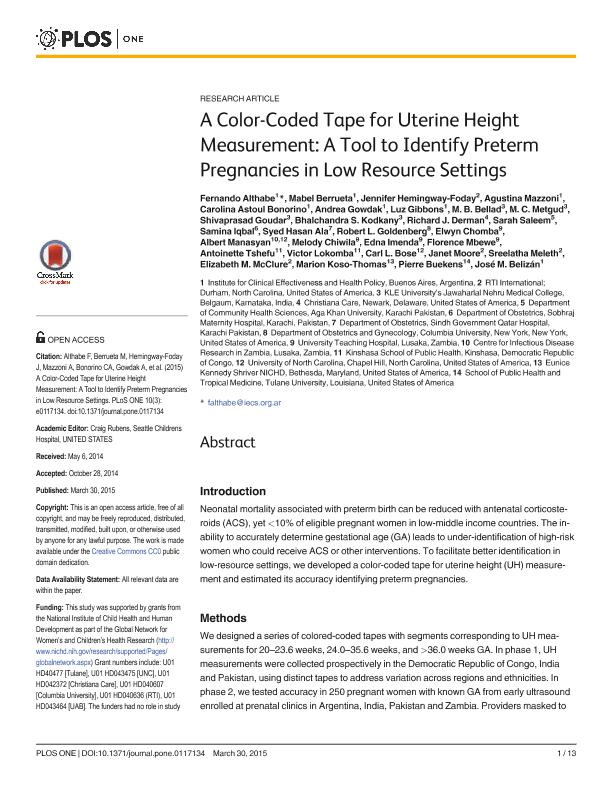Artículo
A color-coded tape for uterine height measurement: A tool to identify preterm pregnancies in low resource settings
Althabe, Fernando ; Berrueta, Amanda Mabel; Hemingway Foday, Jennifer; Mazzoni, Agustina; Bonorino, Carolina Astoul; Gowdak, Andrea; Gibbons, Luz; Bellad, M. B.; Metgud, M. C.; Goudar, Shivaprasad; Kodkany, Bhalchandra S.; Derman, Richard J.; Saleem, Sarah; Iqbal, Samina; Ala, Syed Hasan; Goldenberg, Robert L.; Chomba, Elwyn; Manasyan, Albert; Chiwila, Melody; Imenda, Edna; Mbewe, Florence; Tshefu, Antoinette; Lokomba, Victor; Bose, Carl L.; Moore, Janet; Meleth, Sreelatha; McClure, Elizabeth M.; Koso Thomas, Marion; Buekens, Pierre; Belizan, Jose
; Berrueta, Amanda Mabel; Hemingway Foday, Jennifer; Mazzoni, Agustina; Bonorino, Carolina Astoul; Gowdak, Andrea; Gibbons, Luz; Bellad, M. B.; Metgud, M. C.; Goudar, Shivaprasad; Kodkany, Bhalchandra S.; Derman, Richard J.; Saleem, Sarah; Iqbal, Samina; Ala, Syed Hasan; Goldenberg, Robert L.; Chomba, Elwyn; Manasyan, Albert; Chiwila, Melody; Imenda, Edna; Mbewe, Florence; Tshefu, Antoinette; Lokomba, Victor; Bose, Carl L.; Moore, Janet; Meleth, Sreelatha; McClure, Elizabeth M.; Koso Thomas, Marion; Buekens, Pierre; Belizan, Jose
 ; Berrueta, Amanda Mabel; Hemingway Foday, Jennifer; Mazzoni, Agustina; Bonorino, Carolina Astoul; Gowdak, Andrea; Gibbons, Luz; Bellad, M. B.; Metgud, M. C.; Goudar, Shivaprasad; Kodkany, Bhalchandra S.; Derman, Richard J.; Saleem, Sarah; Iqbal, Samina; Ala, Syed Hasan; Goldenberg, Robert L.; Chomba, Elwyn; Manasyan, Albert; Chiwila, Melody; Imenda, Edna; Mbewe, Florence; Tshefu, Antoinette; Lokomba, Victor; Bose, Carl L.; Moore, Janet; Meleth, Sreelatha; McClure, Elizabeth M.; Koso Thomas, Marion; Buekens, Pierre; Belizan, Jose
; Berrueta, Amanda Mabel; Hemingway Foday, Jennifer; Mazzoni, Agustina; Bonorino, Carolina Astoul; Gowdak, Andrea; Gibbons, Luz; Bellad, M. B.; Metgud, M. C.; Goudar, Shivaprasad; Kodkany, Bhalchandra S.; Derman, Richard J.; Saleem, Sarah; Iqbal, Samina; Ala, Syed Hasan; Goldenberg, Robert L.; Chomba, Elwyn; Manasyan, Albert; Chiwila, Melody; Imenda, Edna; Mbewe, Florence; Tshefu, Antoinette; Lokomba, Victor; Bose, Carl L.; Moore, Janet; Meleth, Sreelatha; McClure, Elizabeth M.; Koso Thomas, Marion; Buekens, Pierre; Belizan, Jose
Fecha de publicación:
03/2015
Editorial:
Public Library of Science
Revista:
Plos One
ISSN:
1932-6203
Idioma:
Inglés
Tipo de recurso:
Artículo publicado
Clasificación temática:
Resumen
Introduction: Neonatal mortality associated with preterm birth can be reduced with antenatal corticosteroids (ACS), yet <10% of eligible pregnant women in low-middle income countries. The inability to accurately determine gestational age (GA) leads to under-identification of high-risk women who could receive ACS or other interventions. To facilitate better identification in low-resource settings, we developed a color-coded tape for uterine height (UH) measurement and estimated its accuracy identifying preterm pregnancies. Methods: We designed a series of colored-coded tapes with segments corresponding to UH measurements for 20-23.6 weeks, 24.0-35.6 weeks, and >36.0 weeks GA. In phase 1, UH measurements were collected prospectively in the Democratic Republic of Congo, India and Pakistan, using distinct tapes to address variation across regions and ethnicities. In phase 2, we tested accuracy in 250 pregnant women with known GA from early ultrasound enrolled at prenatal clinics in Argentina, India, Pakistan and Zambia. Providers masked to the ultrasound GA measured UH. Receiver operating characteristics (ROC) analysis was conducted. Results: 1,029 pregnant women were enrolled. In all countries the tapes were most effective identifying pregnancies between 20.0-35.6 weeks, compared to the other GAs. The ROC areas under the curves and 95% confidence intervals were: Argentina 0.69 (0.63, 0.74); Zambia 0.72 (0.66, 0.78), India 0.84 (0.80, 0.89), and Pakistan 0.83 (0.78, 0.87). The sensitivity and specificity (and 95% confidence intervals) for identifying pregnancies between 20.0-35.6 weeks, respectively, were: Argentina 87% (82%-92%) and 51% (42%-61%); Zambia 91% (86%-95%) and 50% (40%-60%); India 78% (71%-85%) and 89% (83%-94%); Pakistan 63% (55%-70%) and 94% (89% -99%). Conclusions: We observed moderate-good accuracy identifying pregnancies ≤35.6 weeks gestation, with potential usefulness at the community level in low-middle income countries to facilitate the preterm identification and interventions to reduce preterm neonatal mortality. Further research is needed to validate these findings on a population basis.
Palabras clave:
Uterine Height
Archivos asociados
Licencia
Identificadores
Colecciones
Articulos(SEDE CENTRAL)
Articulos de SEDE CENTRAL
Articulos de SEDE CENTRAL
Citación
Althabe, Fernando; Berrueta, Amanda Mabel; Hemingway Foday, Jennifer; Mazzoni, Agustina; Bonorino, Carolina Astoul; et al.; A color-coded tape for uterine height measurement: A tool to identify preterm pregnancies in low resource settings; Public Library of Science; Plos One; 10; 3; 3-2015; 1-13
Compartir
Altmétricas



